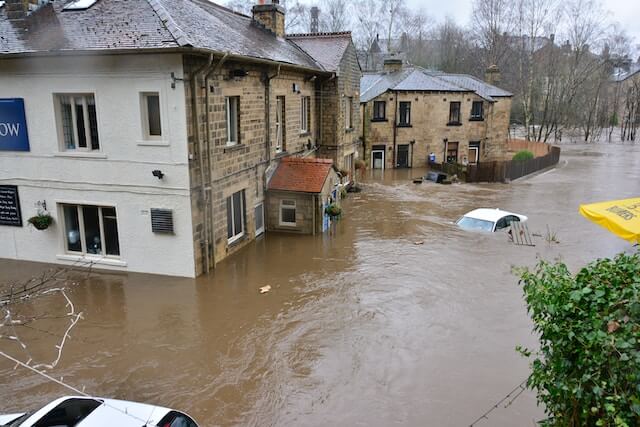Flooding can be a challenging and distressing experience for both landlords and tenants. The potential for property damage, disruptions to daily life, and safety concerns make it crucial for landlords to understand how to effectively handle and minimize the impact of flooding in rental homes. Here is a guide for landlords and rental agents, offering insights into preparation, mitigation strategies, and the recovery process when dealing with flooding incidents.

Preparing for Potential Flooding
Understand flood risks
Research the flood risk in your rental property’s location. Consult local authorities, review flood zone maps, and consider historical flood patterns in the area. This knowledge will help you assess the level of risk and take appropriate measures.
Obtain flood insurance
Regular property insurance typically does not cover flood damage. Encourage your tenants to obtain renter’s insurance that includes coverage for flood-related damages. You, on your end, must consider obtaining flood insurance for the rental property to protect your investment.
Mitigating Flood Damage
Maintain drainage systems
Regularly inspect and clean gutters, downspouts, and drainage systems to ensure proper water flow. Ensure that the property’s grading directs water away from the foundation.
Install flood-resistant features
Consider incorporating flood-resistant materials and features, such as elevated electrical outlets, waterproof flooring, and water-resistant wall treatments. These measures can help minimize damage and facilitate easier cleanup in the event of a flood.

Responding to Flooding Incidents
Ensure tenant safety
Instruct tenants on immediate safety measures during a flood, such as turning off electricity and avoiding contact with floodwater. Communicate emergency contact information and emphasize the importance of following evacuation orders if necessary.
Document and report the damage
Once it is safe to do so, document the flood damage thoroughly with photographs, videos, and written descriptions. Notify your insurance company about the incident promptly and provide all necessary documentation to support your claim.
Claiming Insurance
When it comes to natural floods, insurance coverage can vary depending on the specific policy and the region where the rental property is located. While I can provide general guidance, it is crucial to consult with an insurance professional. Alternatively, you can refer to your insurance policy for specific details and requirements. Here are the general steps to claim insurance for natural floods:
Contact your insurance company
As soon as the flood occurs or you discover it, immediately notify your insurance company. They will guide you through the claims process and provide you with the necessary forms and information.
Document the damage
Take photographs or videos of the affected areas, including any damaged belongings or structural issues. Make a detailed inventory of the damaged items, noting their value and condition before the flood.
Mitigate further damage
Take immediate steps to prevent further damage. You can do this by removing water, drying out the property, and making temporary repairs to prevent additional losses. However, do not begin any major repairs without consulting your insurance company.
File a claim
Complete the necessary claim forms provided by your insurance company. Provide accurate and detailed information about the damage, including the cause, date, and extent of the flood-related losses. Include supporting documentation, such as photographs, videos, and inventory lists.
Cooperate with the insurance company
Work closely with your insurance company’s adjuster or representative. They may visit the property to assess the damage and determine the coverage applicable to your policy.
Review your policy
Familiarize yourself with the terms, conditions, and exclusions of your insurance policy to understand the coverage for natural floods. Some policies may require additional coverage specifically for flood events, as standard homeowner’s insurance may not include flood damage.
Follow the claims process
Cooperate with any additional requests or investigations from your insurance company. Keep records of all communication and document any expenses related to the claim. Some examples are temporary accommodation for tenants or additional living expenses.
Remember, each insurance policy is unique. For that reason, it’s essential to review your policy and consult with your insurance provider. Doing so will help you understand the specific coverage, deductibles, and procedures for claiming insurance for natural floods.

Post-Flood Recovery
After you have repaired the flood damage, utilize Padleads to advertise the availability of your rental property to potential tenants. The website offers a user-friendly platform that allows you to create compelling listings. Additionally, you can syndicate them to popular and high-traffic websites, maximizing exposure to a broader audience.
In the aftermath of a flood, Padleads serves as a valuable tool for landlords to connect with potential tenants. It’s also a too to showcase the property’s post-flood improvements. By leveraging its online listing platform, landlords can efficiently navigate the rental market. They can attract quality tenants who value their proactive approach to flood mitigation and property management. Highlight flood mitigation efforts. Emphasize any flood-resistant features or improvements made to the property in your listing.
Flooding in rental homes can be a stressful and challenging experience for landlords and tenants alike. By taking proactive steps to prepare for potential flooding, landlords can minimize damage, ensure tenant safety, and facilitate a smoother recovery process.